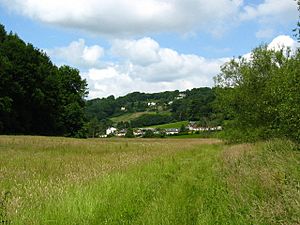1942 Herefordshire TRE Halifax crash facts for kids

Halifax V9977
|
|
| Accident summary | |
|---|---|
| Date | 16.15, Sunday 7 June 1942 |
| Place | Courtfield Estate, Welsh Bicknor, Herefordshire, England 51°51′08″N 2°35′15″W / 51.8522°N 2.5874°W |
| Passengers | 4 |
| Crew | 7 |
| Fatalities | 11 |
| Survivors | 0 |
| Aircraft type | Handley Page Halifax |
| Airline/user | TFU |
| Registration | V9977 |
| Flew from | RAF Defford, Worcestershire |
| Flying to | RAF Defford |
V9977 was a special airplane called a Handley Page Halifax II. It was used during World War II to test new technology. This plane was helping to develop a secret radar system called H2S radar. On June 7, 1942, V9977 crashed in England. All eleven people on board died. One of them was Alan Blumlein, a famous inventor. He created stereophonic sound and an early TV system. Investigators found that a problem with the engine caused the crash. It was the deadliest test flight accident in UK military history.
Contents
The Story of V9977
Building a Special Plane
V9977 was an early version of the Halifax II bomber. This model had more powerful Rolls-Royce Merlin engines. It also had other small changes from the first Halifax planes.
Chosen for Secret Radar
In late 1941, leaders decided to put the new H2S radar on large four-engine bombers. These included the Shorts Stirling, Handley Page Halifax, and Avro Lancaster. Experts looked at different planes. They thought the Halifax was the best for testing the radar. This was because it could hold the radar scanner in different places.
In January 1942, Bernard Lovell was put in charge of the H2S project. He visited the Handley Page factory. His team planned to put a large, round radar dome under the plane. The plane's designers were not happy about this. They had built the Halifax to be fast and carry many bombs. But the radar was very important. Even Prime Minister Churchill said it was a top national priority. So, the radar had to be installed.
V9977 was modified with the radar dome. The radar electronics were built and tested. By late March, the system was ready on V9977. At first, the radar did not work well. It could only see towns a few miles away.
The radar testing team moved their base in May 1942. They moved from RAF Hurn to RAF Defford. This was a safer, more inland location. They kept working on the radar. By early June, it could see towns from 25 to 30 miles away. This was a big improvement!
The Crash Day
On June 6 and 7, 1942, Alan Blumlein and his team visited. They came to see the H2S radar system. They wanted to help get it ready for production.
After their meeting, Bernard Lovell flew in V9977. He saw clear radar images of cities like Gloucester and Cheltenham. The radar was working better than ever.
The next day, Blumlein's team wanted to see it for themselves. They took off in V9977 around 2:50 pm on June 7. They were flying towards the Bristol Channel. Around 4:20 pm, people saw the plane over the Forest of Dean. Its outer right engine was on fire. Soon after, the left wing broke off. The plane rolled over and crashed in a field. This happened near Welsh Bicknor, by the River Wye. All eleven people on board died.
News of the crash reached Defford later that night. Lovell and another team member rushed to the crash site. Their job was to get the top-secret radar part from the wreckage.
What Caused the Crash?
For many years, not much was known about the crash. Some people even thought it might have been sabotage. This was because the plane was so secret.
In the 1980s, a new investigation began. An expert named W.H. Sleigh led it. He talked to people who saw the crash. He also spoke with an engineer who looked at the engine.
The pilot was experienced but new to the Halifax plane. The rest of the crew were not very experienced. The early Halifax planes also had some design problems. For example, the fuel controls were hard to reach.
But the main reason for the crash was a change made by Rolls-Royce. They had changed how engine parts called tappet valves were installed. They made them fit more tightly. This was to stop them from coming loose.
This change was made to V9977's engine just before the crash. One of the nuts holding a valve was not tightened enough. It came loose during the flight. The valve broke off. This caused fuel to leak and catch fire inside the engine. Even though the engine failed, the propeller kept turning. This kept pumping more fuel into the fire.
The fire spread back to the main fuel tanks. The flight engineer needed to cut off the fuel. But he could not reach the controls in time. The fire started at a high altitude. The crew could have jumped out with parachutes. But it is thought that some observers did not have parachutes. So, they stayed with the plane to try an emergency landing. They almost made it. The plane broke apart very close to the ground.
Memorials
Today, the crash site is near the Wye Valley Walk. A memorial was built there. A special service was held on June 10, 2019. This memorial was created with help from a local newspaper and the EMI Archive Trust.
Victims
Eleven people died in the crash. Seven were RAF personnel. The other four were radar scientists, including the famous inventor Alan Blumlein.
See also
- 1942 in the United Kingdom
- List of accidents and incidents involving military aircraft (1940–1942)
- Francis Jones (physicist) and Alec Reeves, who developed OBOE


